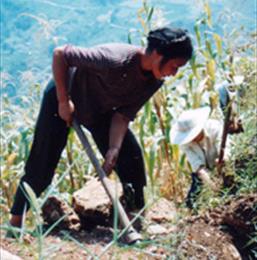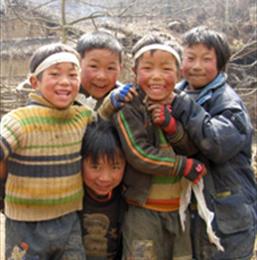Xinli Village, Hanyuan 1998-1999
About a one hour's walk north of Xixi Township Government (itself reached after about one and a half hours' journey by road from Fulin) lies Xinli Village. The village hamlets lie scattered over very steep hillsides and along stream valleys at heights of over 1700m above sea level. Hamlets 3, 4 and 5 are located in deeper valleys, hamlet 1 sits perched on a hillside, whilst hamlets 2 and 6 are nestled in a very steep gully.
Xinli presents some dramatic scenery, the land so steep that the houses are seemingly piled up on top of one another.
The village has a total population of around 600 people. Their main sources of income are grain production, Chinese prickly ash (huajiao) trees, fruit and sunflower seeds. Pigs are reared, but not sold just eaten within the village. Their main 'grain' crops are maize and potatoes (the official definition of 'grain' (Ch. liangshi) in the PRC includes many staple crops that are not technically grain). During our first visit we watched the men and women ploughing and preparing fields, then sowing what were often half potatoes, not yet sprouted, into the prepared ground.
There is no irrigation water available and the altitude of the village is too high to grow rice. The land immediately surrounding the village groups is very steep, but further up the valley there are more gradual slopes and sheltered areas. The village was classified as 'particularly poor' in 1997. The average income per person was around 900 RMB.
The village houses are made of compacted mud walls built upon stone foundations. Many of these houses are quite tall (3 storeys) and have balconies. In and around the village are many small wells and masonry water storage tanks, some lying directly adjacent to fields. The villagers grow prickly ash trees on their field boundaries, some of which had been fashioned into fencing alongside paths. The hillsides around the village were almost totally deforested.
Drinking Water Problem
There is no clean drinking water supply to the village. This problem applies particularly to village hamlets 1, 2 and 6, home to 310 people – hamlet 1 has a population of 160 people, hamlets 2 and 6 over 70 in each. These three groups additionally raise over 1000 domestic animals. At present these villagers have to fetch water either from wells or streams outside of their hamlets. The shallow wells do not provide a consistent supply, and nor are they owned by individuals or managed by them. The water is often dirty. In the winter the water in these wells freezes and during the spring they dry up. Households using these wells must select a clean well and fetch this water for human use - water from dirtier wells is used for animals. In times when the wells run dry, water must be fetched from the hillside above hamlet 6 - a distance of over 1km for residents of hamlets 1 and 2 (a task normally undertaken by women - carrying wooden back buckets). This situation is a year-round problem for hamlet 1, whilst in the summer groups 2 and 6 have a stream running through their valley, although according to women of hamlet 2 this water is also not clean.
DORS Project
Water sources in adjacent valleys could be used. These have water during the winter months but only in their upper reaches. The villagers put forward a plan to pipe water from these sources to points above the hamlets. The County Water Conservancy Bureau has drawn up a plan based on this idea. A small tank at each source will collect the water and from these plastic piping will carry the water distances of approximately 4000m over the hill. Two tanks will need to be constructed in the village (one for hamlets 1 and 2 and another for hamlet 6


